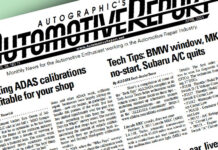Six industry news items and trends you may have overlooked during this past year
By John Yoswick
As another year comes to an end, here are six industry news briefs that might have flown under your radar amid the day-to-day challenges of running your shop, but that could prove helpful for you to know about.
Regulators discuss OEM procedures
Insurance regulators in about half of all states have responded to a letter the Society of Collision Repair Specialists sent out last year asking, among other things, if anything in their state “holds insurers and insurance policies sold in your state accountable to recognize manufacturer documented procedures as a basis for settling claims.”
In one such response, Alex Avalos, senior insurance compliance officer for California’s Department of Insurance, said that state’s “insurance laws and regulations are silent on vehicle manufacturer documented procedures.”
Would the Department consider it a “reasonable expectation that if an OEM repair procedure or instruction existed, that the claim should cover the associated costs?” SCRS asked in its letter.
“That one would need to be looked at on a case-by-case basis,” Avalos responded. “Our regulations mandate that insurance estimates allow for repairs to be made in a workmanlike manner.”
Andy Case, director of the Mississippi Insurance Department’s Consumer Services Division, said there is nothing in state law there that mandates that OEM repair procedures be followed, and that the most an insurer is expected to pay under state regulation is the “lowest amount that such vehicle or glass could be properly and fairly repaired or replaced by a contractor or repair shop within a reasonable geographic or trade area of the insured.”
But Case also went on to say that “if a vehicle manufacturer outlines a specific recommended repair procedure…the Mississippi Department does ask that insurers recognize that procedure as it relates to repair methods only, and not specifically as it relates to the use of specified OEM parts, as Mississippi law currently allows for the use of non-OEM parts.”
Ian Shapiro, insurance analyst with the Illinois Department of Insurance, wrote that his agency “would consider it a ‘reasonable’ expectation that if an OEM repair procedure or instruction existed, the claim should cover the associated costs.” But Shapiro also added that “there is nothing currently written in the statutes that requires an insurance carrier to cover those costs.”
Donald Beatty, deputy commissioner for Virginia’s Bureau of Insurance, wrote in his response to SCRS that standard policy forms insurers must use in his state would not allow an insurer to say costs associated with automaker procedures are not covered, but those forms also “do not require insurers to accept manufacturers’ procedures for repair.”
In perhaps even more troubling news for shops and their customers, Suzanne Tipton, insurance deputy commissioner of the Arkansas Insurance Department, wrote that if an insurer directs a shop not to follow OEM repair procedures, that “may be considered to be reasonable” as long as the vehicle “is shown to have been ‘restored to its condition prior to the loss.’”
SCRS Executive Director Aaron Schulenburg said that, overall, “What was evident from the responses was that there was either a lack of understanding, or there truly are gaps in statute that don’t identify this at all [other than] language that holds the carriers responsible for making parties whole.”
Sales versus net profit
Higher sales did not always translate into higher net profits for shops who reported stronger year-over-year revenue in the second half of 2018, according to “Who Pays for What?” survey data. In fact, 29 percent of the more than 650 shops responding to the questions about sales and profits said that although revenue was higher for the second half of 2018 compared to the same period in 2017, their net profit was the same (21 percent) or even lower (8 percent).
Conversely, of the shops that said their year-over-year sales were down, 29 percent said that their net profit was the same, and 10 percent said their net was even higher than for the same period a year earlier.
Overall, more than one in five shops (22 percent) reported a lower six-month net profit compared to the prior year.
Repairable vehicle population jumps
The number of “potentially repairable vehicles” on U.S. roads rose by 1.2 million in 2018, the beginning of an expected five-year period of rapid increases in that number, according to an analysis by CRASH Network. If new auto sales maintain even half of the previous 30-year average annual increase, another 5.5 million “potentially repairable vehicles” will be added to the U.S. light vehicle population each year for the next five years.
This projection is based on the fact that one of the primary factors affecting the number of repairable vehicles coming into shops is simply how many vehicles on the road are new enough to be repairable if damaged. Obviously, the more such cars there are — primarily cars and light trucks 10-years-old or newer — the more there are to potentially repair.
The number of vehicles in that age group took a huge downward turn when new car sales tanked throughout the recession (19 million fewer new cars were sold between 2008 – 2012). At the end of 2018, there were about 166 million light vehicles on the road that were 10 years old or newer; that’s about as many as there were 18 years ago.
But by next year, that number should rise to about 178 million, 12 million more than now. This is dependent, of course, on the sales rate of new cars. This analysis assumes less than a 1 percent annual growth rate the sale of new cars, much less than the 1.73 percent average annual growth rate from 1967 – 2007. If that occurs, the number of cars on the road that are 10 years old or newer will rapidly increase — and surpass the record-high levels set just prior to the recession — over the next four to five years.
More shops being paid paint department procedures
Among the not-included labor procedures that an increasing percentage of shops say they are regularly being paid to do is masking the engine compartment when necessary during refinishing. Back in 2015, the first “Who Pays for What?” survey, conducted quarterly by Collision Advice and CRASH Network, found that only about one-third of shops said the largest eight insurers nationally paid “always” or “most of the time” to protect the engine compartment during refinishing following repair or replacement of core supports, aprons, frame rails, firewalls, etc. That had risen to about 45 percent of shops last year, and grew again to a narrow majority of shops (51 percent) in this year’s survey.
The percentage of shops that said they had never sought to be paid for masking the engine compartment fell to about 31 percent this year, down from about 36 percent in 2015.
More shops also report being paid regularly for precision masking (or “roping”) of glass. About 83 percent of shops now say they regularly are paid for that procedure, compared to just 69 percent back in 2015.
Industry employment, wages growing
The latest data from the Department of Labor (DOL) shows not only the wide range of wages in the collision repair industry, but also that wages overall have been steadily rising on a national basis over the past several years.
The DOL reports a median wage — the annual salary at which half of the industry’s technicians in a particular state earn more and half earn less — for each state for both body technicians and painters. Comparing the average of all states’ median wages for body technicians over that time shows a rise from $40,926 in 2014 to $42,808 in 2018, an increase of 4.6 percent
Painters have seen an even larger increase in wages, going from an average median wage of $41,596 in 2014 to $44,987 in 2018, an 8.2 percent increase.
But considering the 5.8 percent rate of inflation during that same time period, it appears that while painters have seen their real wages improve, body techs’ rate of wage growth has not even kept pace with inflation.
The DOL report also estimates that the labor force of body techs has grown. In 2014, the DOL estimated there were 87,820 autobody repairers in the autobody and glass industries. By 2018, that estimate had reached 92,580, a 5.4 percent increase.
Demand for techs leading to signing bonuses
A survey of more than 600 shops this past April found that more than 60 percent currently had a vacant position for a body technician. Even more — over 80 percent — say that even if they aren’t currently advertising an opening, if a qualified body tech walked in the door looking for a job today, they would hire them immediately, and nearly two out of five shops said they would hire more than one.
The survey found that although body techs clearly are in high demand, shops are seeking to fill other production positions as well. About one in four shops had current openings for body helpers, painter helpers and estimators. About 15 percent of shops said they were currently looking to hire a painter.
The survey also showed that the competition for technicians is getting so high that some shops have turned to offering signing bonuses to attract new talent. More than 90 of the shops (14 percent) said they have offered signing bonuses within the past 12 months. Although most of these shops have offered bonuses under $2,000 to a new tech, nearly one in five of the shops have paid bonuses of $4,000 or more just to attract a single technician. Another 27 percent of the shops offering signing bonuses fell somewhere in between, offering bonuses of $2,000 to $4,000 for a single tech. •
John Yoswick, a freelance writer based in Portland, Ore., who has been writing about the automotive industry since 1988, is also the editor of the weekly CRASH Network (www.CrashNetwork.com). He can be contacted by email at john@CrashNetwork.com.



